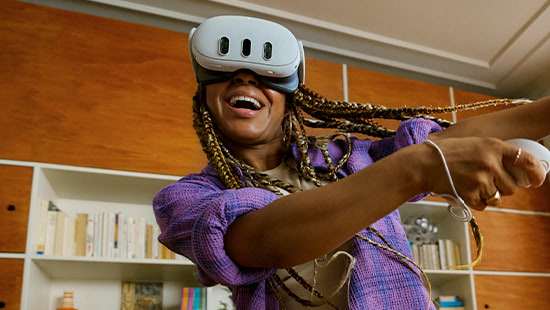What Are VR Headsets & Smart Glasses? | O2

What’s the difference between VR headsets and smart glasses?
Everything you need to know about these futuristic, fun-tastic tech investments.

What are VR headsets?
Go on, slip a VR headset over your eyes. You’re now viewing a screen through which you can explore the “worlds” of games, films and other 3D digital environments, much like how you’d interact with your real physical surroundings. VR headsets contain motion sensors, allowing you to experience changing viewpoints as you move your head. Many headsets come with built-in speakers (for highly realistic 3D audio) and eye-tracking tech (so you can move your VR gaze just like you do in real life). They’re a seriously exciting investment if you want to take your immersion in entertainment to the next level.

The VR headset to know now
Suitable for ages 13 and up, the new Meta Quest 3 wireless headset blends virtual elements with your real surroundings. Dive into adventures in “mixed reality” as you explore a vast library of over 500 titles, covering gaming, fitness, entertainment, social and more. For example, you can work out in your bedroom alongside a virtual trainer. Or open a portal to a new dimension through your living room wall. Thanks to the Meta Quest 3’s 4K+ Infinite Display resolution and boosted graphic processing power, these VR worlds feel more real (and load quicker) than ever. Sounds exciting, right? That’s not all – you can now get Asgard’s Wrath 2 free when you buy a Meta Quest 3, with a 6-month trial of Meta Quest+ free when upgrading to 512GB until 27 January 2024.

What are smart glasses?
Rather than transporting you into an imaginative virtual world like VR headsets, smart glasses offer the brilliant capabilities of a smartphone – hands-free. They look like normal reading spectacles or sunglasses. But they’re fitted with wireless internet connectivity and imaging capabilities, just like a smartphone. Smart glasses can connect to your smartphone; play sounds and music through the arms, so you don’t have to wear headphones; and contain microphones for hands-free phone conversations and voice commands. Augmented reality (AR) glasses are one step up from smart glasses and include digital displays in the lenses that can add information to what you see.

The smart glasses to know now
With sleek, lightweight frames in seven colourways, including tinted and clear lenses, the Ray-Ban Meta Wayfarer looks as stylish as any other pair by the iconic eyewear brand. The difference: they’re smart and come packed with Meta technology, fitted with a new ultra-wide 12MP camera and five-mic system. That means you can take high-quality photos and immersive videos exactly as you see them. Oh, and you can livestream everything to Facebook and Instagram if that’s your thing. Discreet speakers deliver a rich listening experience for your ears only, even if you’re somewhere noisy or windy. And once you’ve linked your glasses to your smartphone, you can call, message and more through hands-free voice command. With up to four hours of battery life and a portable charging case slim enough to fit in your pocket, the next generation of smart glasses is here.



